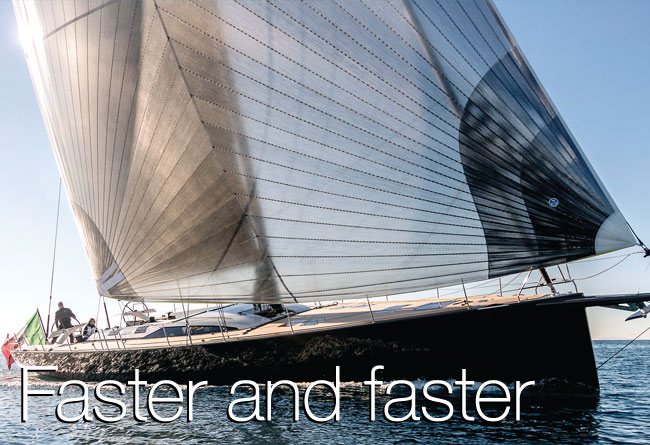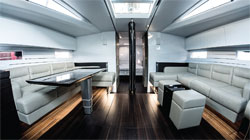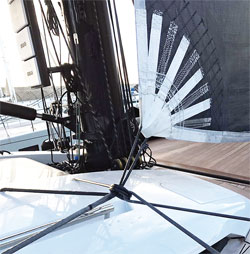

The new 65-footer from Mylius is just the latest example of a type of boat that would once have been considered inconceivable
Following experience gained from the Mylius 19E95 (the name means 19 metres and 95 centimetres, a little over 65ft), the Mylius 65 is the latest model from this Italian brand – an all-new design from masthead to keel-tip compared with its successful predecessor.
Built in carbon, this pretty yacht offers an owner the opportunity to dip a toe into the world of maxi yachts with style, quality and performance… but without needing dozens of expensive crew to go racing. The Mylius 65 is available in a flush-deck version, seen here, or with a raised saloon version – like the second example now under construction. The third boat in the yard will be another flush-deck!
The new Mylius 65 features a better sail area/displacement ratio and slightly more waterline length in comparison with its predecessor. The hull is also significantly beamier, especially in the aft sections, with more form stability, offering improved downwind pace and better directional stability when sailing at high speeds.
The increased form stability was a key goal with the new design, not only while racing with a crew on the rail but, maybe even more important, in cruising mode when a more ‘relaxed’ smaller crew can benefit from the comfort of less heel.
Even with its luxurious fit-out, this new 65 displaces just 20 tonnes with its carbon construction, less than any other boat of this type. She is a perfect example of the modern fast cruiser-racer, a yacht with a full cruising interior that is also ready for serious racing.
Hull, deck, ribs, bulkheads and chainplates are all constructed in carbon-PVC sandwich, with solid laminate in the areas of keel, mast, rudder and engine. All composite elements employ an epoxy matrix tailored for the yacht. The design’s structural analysis is based on ISO 12215, all carefully optimised using finite element (FEA) analysis. The lamination of hull and primary structure is also validated at various stages using NDT ultrasonic checks. The interior elements complement the overall structure in terms of rigidity and robustness.
Launched in November 2016, Oscar 3 is the second Mylius where the yacht’s owner, with extensive experience in nautical interior design, on motor yachts as well as sailing craft, has worked alongside Mylius’s own design team, creating experimentation and innovation in the layout, details and furnishing materials. Therefore, it is little surprise that the end result, Oscar 3, is an innovative and different yacht, but one that still carefully retains the ‘Mylius look’.
The deck is finished in teak, vacuum bonded to the main structure. The distinctive aesthetic element on this 65, as on all the latest Mylius yachts, is a low and elegant coachroof that appears to be ‘suspended’ above the deck. Most noticeable are the elegant integrated skylight hatches, using technology borrowed from the Twinpack Group – a 51 per cent shareholder in Mylius Yachts.
The mainsheet winch is mounted on a tower, while primary and secondary winches are arranged at the aft end of the cockpit area. All lines are concealed below deck.

The interiors on these boats just get better and better (above) while sailing systems borrow all the best bits of modern race technology – such as this tidy headsail sheet system (below). The Aldo Parisotto interiors feature joinery and leatherwork that would not disgrace your latest new Bentley… All of the Mylius yachts continue to be designed and built built at the company’s original boatyard in Podenzano near to Milan

The deck plan is, therefore, extremely clean. There are no jib tracks, a barber system being used for the racing jibs, while there is a transverse track for the self-tacking jibs that are fitted for cruising. Gennakers and other asymmetric sails are flown off the fixed carbon sprit, which also doubles up doing duty as the forward anchor arm. The mast and imposing Park Avenue boom are of course also made in carbon by Hall Spars. The boat has a fixed keel (the fin being machined in Weldox 700 steel).
Though driven by ‘performance with style’, the boat itself remains free of clutter and ‘overly clever’ radical solutions; sometimes with yachts of this type we see examples where a proliferation of superficially appealing gadgetry actually make an owner’s life harder rather than more easy.
The Mylius 65 interiors are in smoked eucalyptus and open pore oak. The dinette is a large open space, clean and very light, with facing sofas in fine leathers.
The owner’s area, accessed via a carbon sliding door, is configured as a large self-contained suite. The access passage is also clad with leather while storage closets adopt a contemporary twist, as far as materials, finishes and accessories are concerned, employing a classical ‘suitcase theme’ that will be very familiar to frequent users of the first-class airline lounge…
Aft of the companionway ladder, the galley presents an extremely spacious work area thanks to the positioning of the sink beneath the stairs themselves. To starboard there is the chart table and a two-bed crew cabin. Further aft are two twin guest cabins, each ensuite and with a separate shower.
The sail locker is equipped with a further small toilet and shower, mainly for use when the yacht is at anchor while the guests are swimming. The stern garage can accommodate a tender up to 2.7m.
As with all recent Mylius yachts, the new 65 benefits from the latest yacht-management technologies and electronic control systems developed in partnership with the R&D department of the Twinpack Group. The main electrical system is based on the Mastervolt Masterview package, which allows activation of all of the onboard systems using either the touch screen PC at the navigation table or a second remote connection, all using custom-written Mylius in-house software. The hardware for the electrical system runs through carefully integrated conduits up and down the hull. All cables are in the finest marine grade coppers, neatly identified at each end using a proprietary permanent marking system. All details are then recorded on the yacht’s complex but accessible cable schedule, with reference to the appropriate onboard drawings. All of the autopilot, navigation and related software was developed by Mylius working in partnership with B&G.
All the yacht’s other primary systems are designed to be easy to use and maintain, with methodologies borrowed from other industries as well as from within the Twinpack Group. For example, the plumbing system runs along the side of the hull in such a way as to minimise flow restrictions and allow easy access to the pipework. The structural carbon water tanks have electrical shut-off valves operated from the touch-screen panel.
We were able to check the boat’s agility sailing and tacking without problems in a light breeze of 5-6kt. The self-tacking jib, though a little small to be ideal in the light conditions, nevertheless allowed the yacht to sail at good upwind angles at around 6kt and to be tacked quickly and easily. As soon as we bore away and set the code zero the speed rose rapidly to 8kt, hitting 9.5kt during one gust of… 7.5kt!
Even in so little breeze the boat was fun to helm, responsive and accelerating quickly in any increase in breeze, but with the inertia to glide through the holes in the wind.
We later sailed the Mylius 65 again using the yacht’s North 3Di racing sails. With 18-20kt almost all boats move well, but this luxurious 65-footer proved to be wellbalanced, heeling as designed and transforming wind power into speed without any apparent handling challenges. The boat felt more forgiving than a pure racer, but still offers great emotions. She is expected to be competitive in all the major competitions, especially over coastal and offshore courses where her offwind pace should deliver a sparkling performance.
MYLIUS
The Mylius story began in 2003. Twinpack Group – world leaders in the packaging industry – took a 51 per cent stake in 2011. Twinpack is headed by Luciano Gandini, a passionate sailor and owner of a string of well-known yachts. The expanded resources that became available with the Twinpack investment have allowed the yard to grow, combining shipyard skills and design excellence with a strong industrial and financial base.
Involved from the start of the company is Alberto Simeone who has filled the role of lead designer on every Mylius yacht built to date. The use of an in-house designer, like Rod Johnstone at J/Boats or Niels Jeppesen at X-Yachts, gives all models the same distinct flavour while also ensuring a coherent evolution from boat to boat.
Click here for more information on Mylius »
We invite you to read on and find out for yourself why Seahorse is the most highly-rated source in the world for anyone who is serious about their racing.
To read on simply SIGN up NOW
Take advantage of our very best subscription offer or order a single copy of this issue of Seahorse.
Online at:
www.seahorse.co.uk/shop and use the code TECH20
Or for iPad simply download the Seahorse App at the iTunes store


